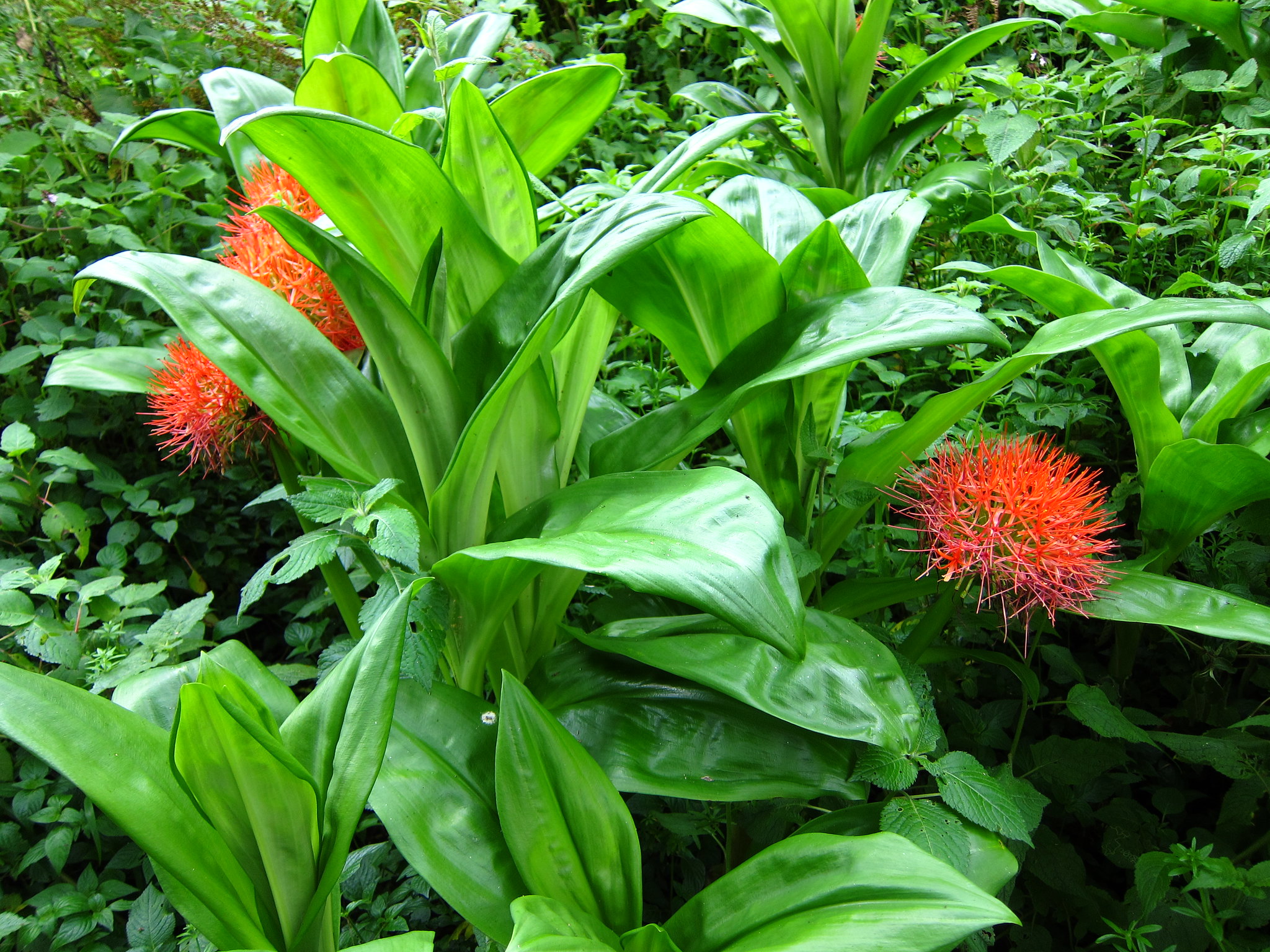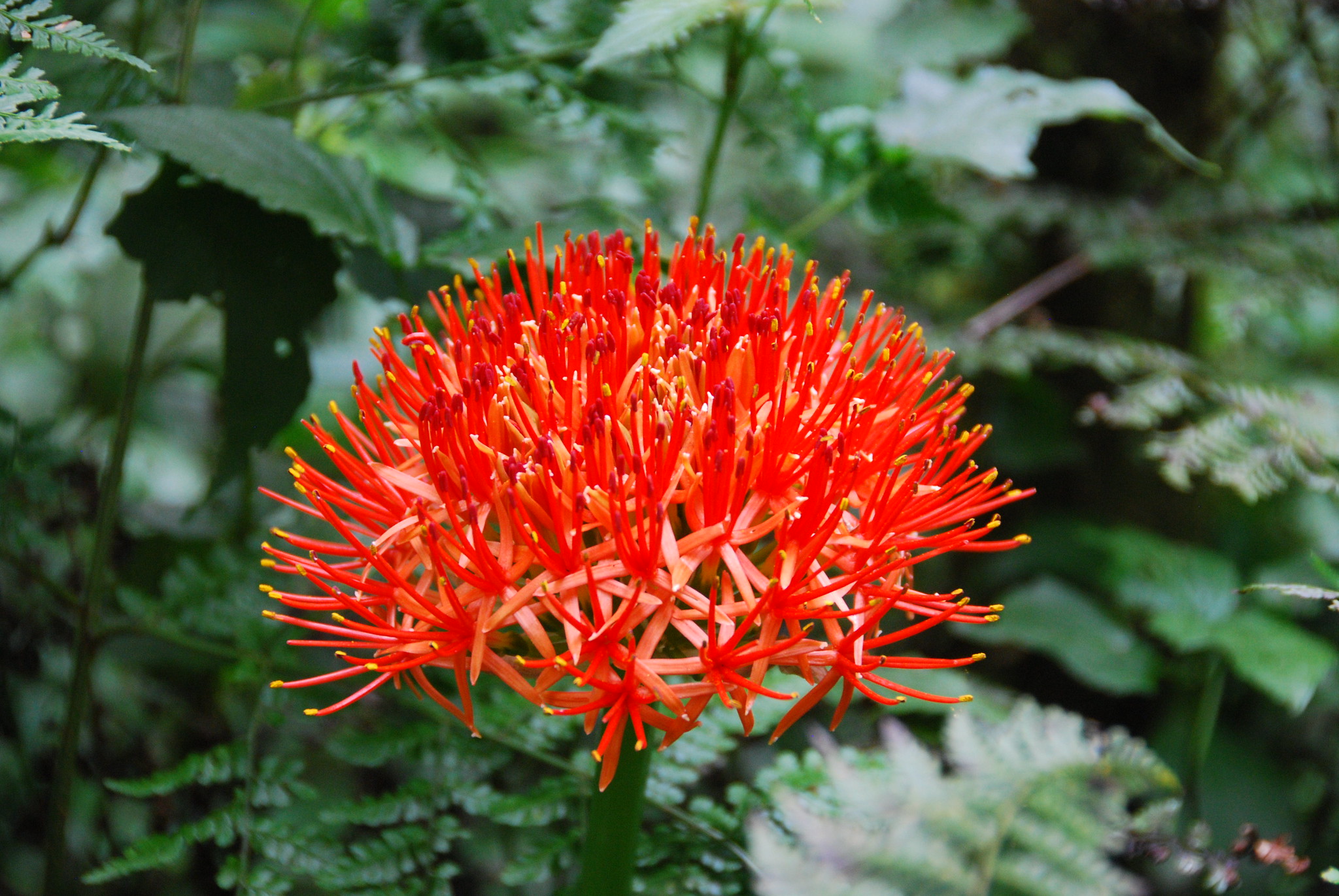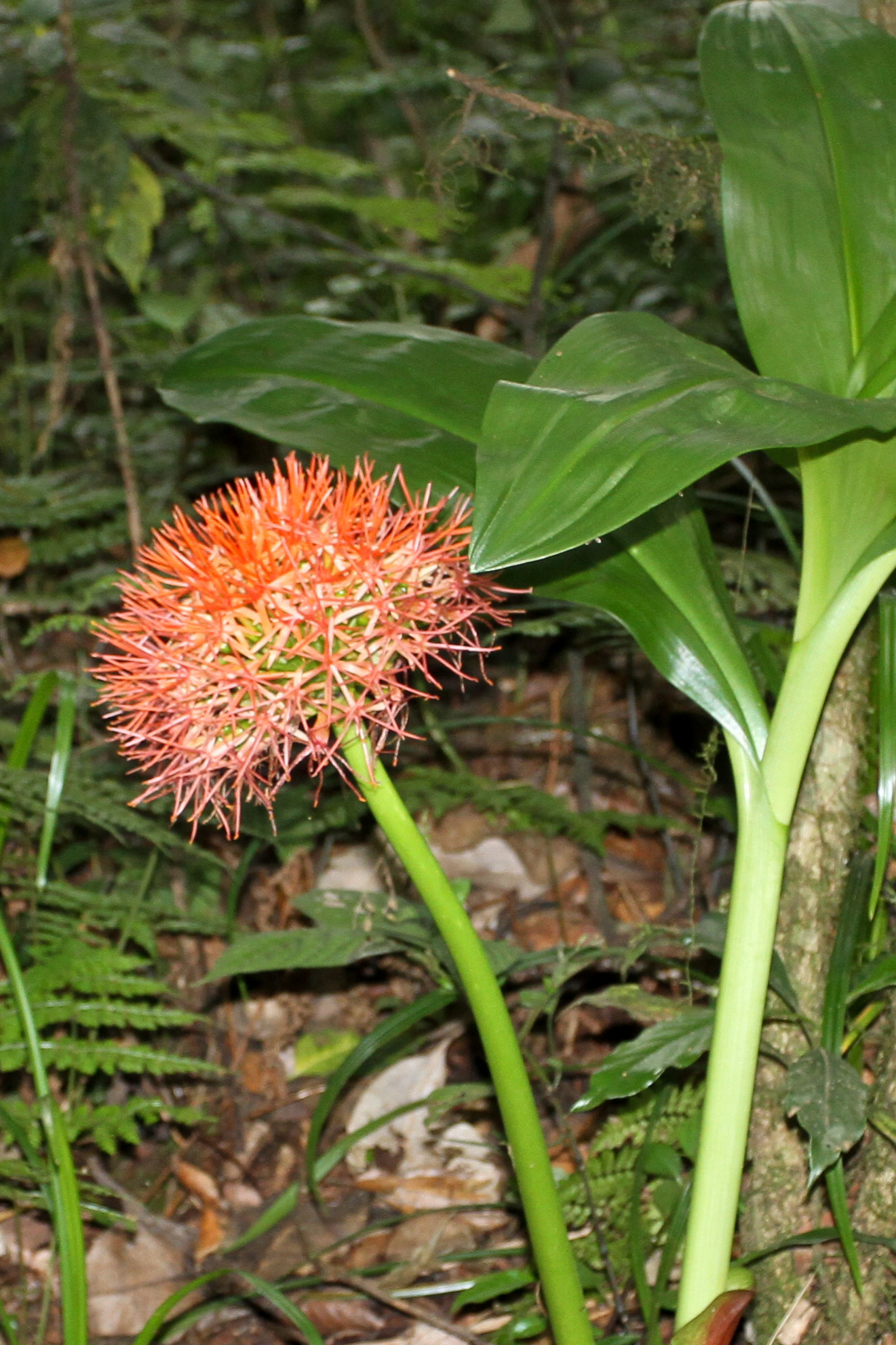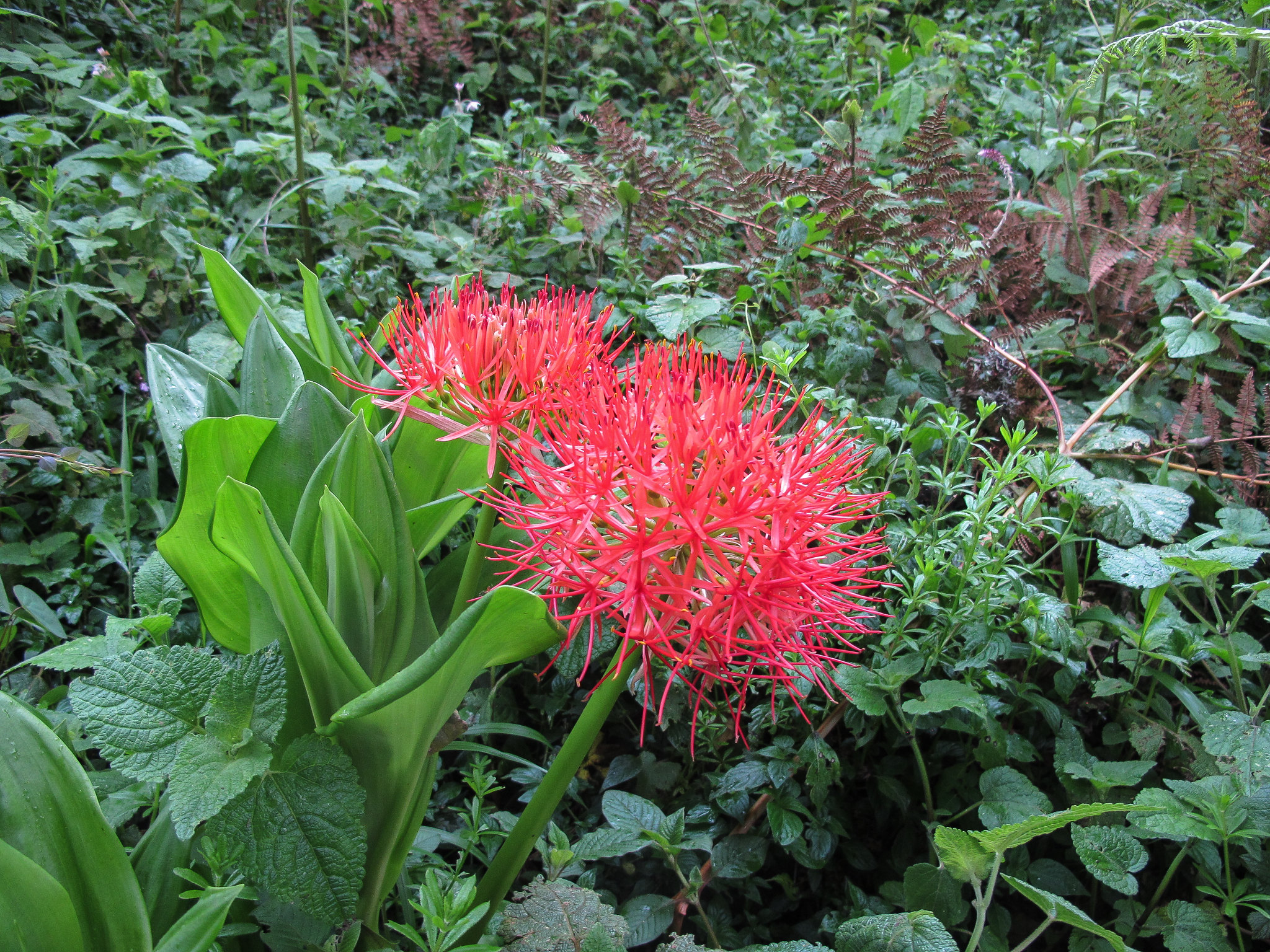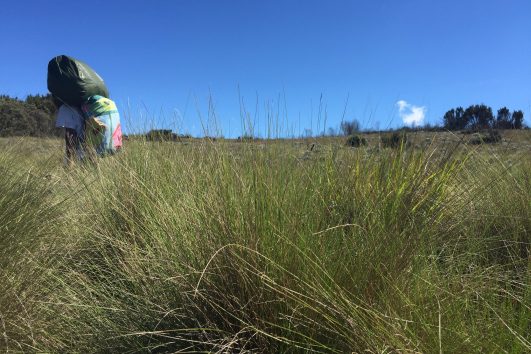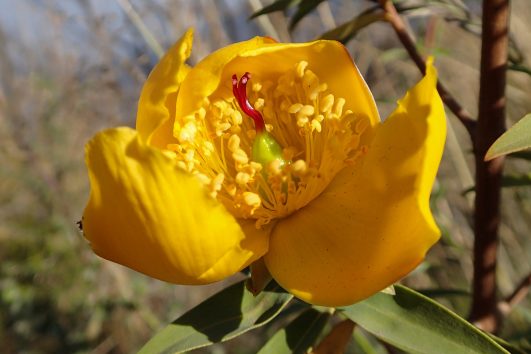The Fireball Lily, scientifically known as Scadoxus multiflorus, is often referred to by other common names like Blood Lily or Powderpuff Lily due to its vibrant, globe-shaped flower head that resembles a fiery explosion or a dense puff of colour. Fireball Lily (Scadoxus multiflorus), also known as the “African Blood Lily,” this vibrant plant is famous for its spectacular, globe-shaped flower heads that light up the landscape with fiery hues of red and orange.
Comprising up to 200 small florets, the stunning flowerhead is a huge spherical mass that can develop to a diameter of 9 inches wide. In a season, each plant will provide one flowerhead.
If consumed, the bulbs are poisonous. Fishing poison and poison tip arrows are made from the extract.
Habitat: Finding the Fireball Lily on Kilimanjaro
The Fireball Lily thrives in the montane and submontane zones of Mount Kilimanjaro typically found between 1,500 and 3,000 meters (4,900 to 9,800 feet) above sea level. These zones are characterized by moist, shaded environments provided by the dense canopy of rainforest trees. The lily favours well-drained, fertile soils rich in organic matter, often growing in the understory of the forest where it receives filtered sunlight.
In these humid and cool environments, the Fireball Lily can be spotted along the forest floor, on the edges of clearings, and sometimes along riverbanks. Its preference for shaded areas makes it a common sight in the more secluded parts of the forest, away from direct sunlight and human disturbances.
- Appearance:
- Flower: The most striking feature is its large, spherical flower head, which can be up to 12 inches in diameter. The flowers are typically bright red to orange-red, with individual florets that give the flower head a fluffy, almost powdery appearance.
- Leaves: After or sometimes simultaneously with flowering, the plant produces broad, strap-like leaves that are semi-succulent, providing a contrast to the flower’s fiery appearance.
- Habitat and Origin:
- Native Range: Scadoxus multiflorus is native to sub-Saharan Africa, stretching from Senegal to Somalia and southwards, as well as parts of the Arabian Peninsula. It thrives in various environments from tropical to subtropical climates, often found in shaded, moist areas under trees or along riverbanks.
- Ecological Role:
- Pollination: The bright, nectar-rich flowers attract a variety of pollinators, including birds and insects, making it an ecological asset in its native habitats.
- Cultural and Horticultural Interest:
- Ornamental Use: Due to its dramatic flowers, it’s a favourite among gardeners for tropical or exotic garden themes. It’s particularly valued for its ability to add a splash of colour in shaded garden areas where many plants might not thrive.
- Symbolism: While not universally symbolic, its fiery appearance might be associated with passion or vitality in garden symbolism.
- Care Tips:
- Light: Prefers bright, indirect light or partial shade. Direct sunlight can be too harsh, especially in hotter climates.
- Water: Keep the soil moist but well-drained during the growing season. Reduce watering when the plant goes dormant, which typically coincides with cooler months.
- Soil: A well-draining, loamy or sandy soil rich in organic matter suits it best. Good drainage is crucial to prevent bulb rot.
- Temperature: It’s sensitive to frost, requiring a minimum temperature of around 50°F (10°C) for tropical variants, with some southern African forms tolerating slightly cooler conditions but still needing protection from frost.
- Humidity: Medium to high humidity is preferred, which can be maintained by misting or using humidity trays if grown indoors.
- Fertilization: Benefits from a high-phosphorus fertilizer during its growth period to encourage blooming.
- Propagation: Can be propagated from seeds or by dividing the bulbs, which should be done when the plant is dormant.
Description of the Fireball Lily
The Fireball Lily is a striking plant that catches the eye with its vibrant and distinctive appearance. Here’s a closer look at its key features:
- Flower Heads: The most defining characteristic of the Fireball Lily is its large, spherical flower heads, which can reach up to 20 centimetres (8 inches) in diameter. Each flower head is composed of numerous small, star-shaped florets that form a dense, ball-like structure. The florets are bright red or orange-red, giving the flower head its fiery appearance. These vivid colours are not only visually stunning but also serve to attract pollinators, such as bees and butterflies.
- Leaves: The Fireball Lily has broad, glossy, dark green leaves that emerge from the base of the plant. The leaves are elongated and can grow up to 45 centimetres (18 inches) in length. Their smooth, fleshy texture helps the plant retain moisture, which is essential for surviving the drier periods of the year.
- Stems: The flower heads are supported by thick, fleshy stems that can grow up to 60 centimetres (24 inches) tall. These sturdy stems ensure that the heavy flower heads are held high above the ground, making them more visible to pollinators and less susceptible to ground-dwelling herbivores.
Life Cycle and Blooming Period
The Fireball Lily is a perennial plant, meaning it lives for several years and blooms annually. The plant’s life cycle is closely linked to the seasonal changes in its environment:
- Dormancy: During the dry season, the Fireball Lily enters a period of dormancy. Its above-ground parts die back, leaving only the underground bulb to survive the harsh conditions. This bulb stores nutrients and water, allowing the plant to endure the dry months.
- Growth and Blooming: With the arrival of the rainy season, the Fireball Lily springs back to life. The bulb sends up new leaves and flower stems, and within a few weeks, the vibrant flower heads appear. The blooming period usually occurs from late spring to early summer, depending on the onset of the rains.
- Pollination and Seed Production: The bright flowers of the Fireball Lily are designed to attract pollinators. Bees and butterflies are the primary visitors, drawn by the vivid colours and sweet nectar. Once pollinated, the flowers produce small, round fruits that contain seeds. These seeds are dispersed by wind or animals, ensuring the propagation of the species.
Additional information
| Habitat | Montane Forest Zone |
|---|

